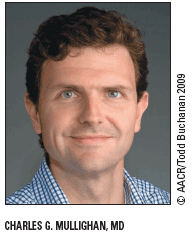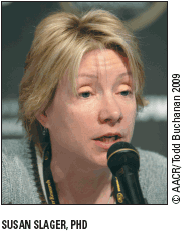AACR research sheds light on value of genetic make up of hematologic disorders
DENVER-Studies at AACR 2009 demonstrated the early identification of patients who may be susceptible to various forms of leukemia and lymphoma, and hinted at therapies for prevention and treatment.
Genetic variants, mutations, and methylation patterns play a part in disease susceptibility, progression, and response to treatment.
DENVER-Studies at AACR 2009 demonstrated the early identification of patients who may be susceptible to various forms of leukemia and lymphoma, and hinted at therapies for prevention and treatment.

“There is a bit of debate now about the value of genetic information-particularly from genome-wide associations-for predicting disease,” commented John Witte, PhD, professor of human genetics at the University of California, San Francisco. “The different studies have found particular genetic variants, mutations, copy numbers, and methylation patterns that may affect the risk of disease, progression of disease, or response to treatment.”
Immune disruption in CLL
Altered immune status may appear as early as 9.8 years before chronic lymphocytic leukemia (CLL) develops, according to NCI investigators.
Scrutinizing data from the Prostate, Lung, Colorectal and Ovarian Cancer Screening Trial (PLCO), Neil Caporaso, MD, and colleagues noticed that some of the CLL patients had proteins, known as free-light chains, in their serum years before diagnosis (abstract 1680).
The PLCO trial enrolled 77,469 healthy individuals.

“This is the first prospective study to identify abnormal free light-chains present in individuals who later developed CLL as far as 10 years later,” said Dr. Caporaso, section chief of the genetic epidemiology branch at NCI in Bethesda, Md.
“We found that 41 out of 109 patients with CLL had free light-chain proteins floating around in their blood as far as 9.8 years prior to diagnosis. That’s about 38% of the group.”
JAK mutations in pediatric ALL
Researchers suggested that treatment with experimental drugs targeting Janus-associated kinases (JAK) may help children diagnosed with acute lymphoblastic leukemia (ALL). These results expand the range of diseases associated with JAK mutations and show that lesions targeting multiple pathways, including lymphoid development (IKZF1), tumor suppression (CDKN2A/B), and tyrosine kinases (BCR-ABL1 or JAK), cooperate to induce aggressive ALL, according to the group.
Children who have mutations in the JAK tyrosine kinase gene tend to have very poor outcomes and a higher rate of recurrence of their leukemia, said Charles G. Mullighan, MD, from St. Jude Children’s Research Hospital in Memphis, Tenn.

“These mutations can currently be identified using standard genetic testing. Drugs are being developed that can be used against these JAKs, and JAK inhibition clearly warrants clinical evaluation in this subset of patients,” Dr. Mullighan said. One of those drugs, XL019 (Exelixis), shows activity in vitro in the JAK mutations, and is being considered for clinical trials, he said (abstract LB-92).
His group performed a genetic analysis of 187 Children’s Oncology Group clinical trial participants with B-progenitor ALL at high risk of relapse. The presence of JAK mutations was associated with a deletion of the genes IKZF1 and CDKN2A/B and poor outcome. The four-year incidence of relapse was 71% for patients with JAK and IKZF1 alterations, compared with 23% for patients with neither alteration.
Genetic susceptibility variants for CLL
Researchers at the Mayo Clinic in Rochester, Minn., confirmed previous findings of a group of genetic variations that appear to increase CLL risk.
“We have validated genetic variants that may help explain why people who have family members who have CLL are eight times more likely to also get the disease than members of the general population,” said Susan Slager, PhD, associate professor of biostatistics.
Dr. Slager explained that a recent genome-wide association study of CLL identified seven genetic variants. Mayo researchers reviewed peripheral blood samples collected from 399 CLL cases and 632 controls. Of the cases, 99 patients were from high-risk families (abstract 96).

“We confirm the previous findings of susceptibility genes for CLL for all but one of these polymorphisms in an independent U.S. Caucasian sample,” Dr. Slager said. “Our results further support the role of a genetic basis in the etiology of chronic lymphocytic leukemia.”
Anti-leukemic efficacy of bisphosphonates
About 35% of mice that are bred to develop radiation-induced leukemia do not get the disease if they are treated with bisphosphonate drugs, possibly opening up a therapy for military workers exposed to radiation or patients undergoing intensive radiation procedures for other illnesses.
Alexandra C. Miller, PhD, and colleagues sublethally exposed mice to 3.5 Gy radiation, which was enough to cause leukemia in this genetically engineered rodent model. All of the mice irradiated who were not treated with a bisphosphonate developed leukemia. But 25% to 35% of the mice that were treated with the bisphosphonates remained disease-free a year after exposure (abstract 1799).
“We still have a lot of work to do, including eliciting the mechanism by which bisphosphonates prevent leukemia in this animal model,” said Dr. Miller, a radiation biologist and senior scientist at the Armed Forces Radiobiology Research Institute in Bethesda, Md.
Wine consumption and NHL
Women diagnosed with non-Hodgkin’s lymphoma (NHL) who drank red or white wine appeared to have significantly longer overall survival than women who did not drink wine (abstract LB-243). About 76% of the women who reported drinking wine survived five years after their NHL diagnosis, compared with 68% of those women who didn’t drink wine (P = .0064), said Xuesong Han, a research epidemiologist and doctoral candidate at the Yale School of Public Health in New Haven, Conn.
The researchers used data from the Connecticut Tumor Registry (1995-2000) to identify and analyze the drinking habits of 546 women with histologically confirmed NHL.
“We also found that women who had a long-term history of drinking wine-greater than 25 years- had a reduced risk of death from non-Hodgkin’s lymphoma,” she said. “These data pre-date their disease diagnosis. Their risk for death from non-Hodgkin’s lymphoma was reduced by 33%.” n
Late Hepatic Recurrence From Granulosa Cell Tumor: A Case Report
Granulosa cell tumors exhibit late recurrence and rare hepatic metastasis, emphasizing the need for lifelong surveillance in affected patients.